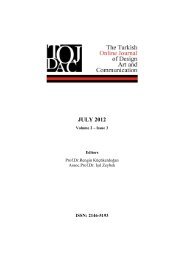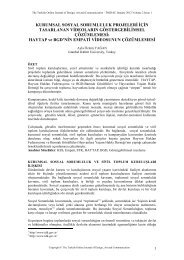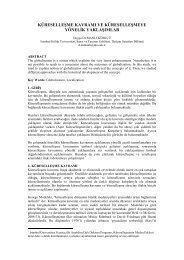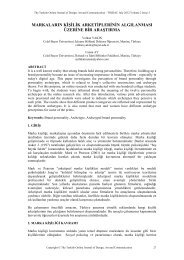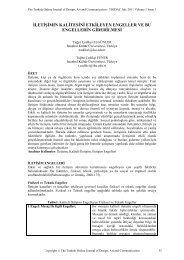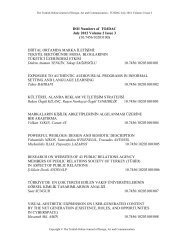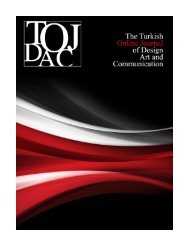aprıl 2012 - tojdac.org
aprıl 2012 - tojdac.org
aprıl 2012 - tojdac.org
You also want an ePaper? Increase the reach of your titles
YUMPU automatically turns print PDFs into web optimized ePapers that Google loves.
The Turkish Online Journal of Design, Art and Communication - TOJDAC April <strong>2012</strong> Volume 2 Issue 2<br />
7. CONCLUSION<br />
Hybrid media changes the way we look at the image and design. Within all elements forming<br />
the image, all constants are substituted by continuously changing variables controlled by the<br />
designer. Manovich expresses the idea of today’s visual culture can be called the “continuity<br />
turn” [10]<br />
So it’s better to arise the question of what will this continuity bring to design processes.<br />
Working with interdisciplinary fields, the designer is face to face with a challenge for<br />
discovering the unexplored potential of new aesthetics. The images designer creates are as<br />
limitless as one’s imagination. But it takes talent and genius to extract the creative ideas from<br />
the possibilities of software-using skills.<br />
According to Manovich the hybrid image will skillfully play on the visual and semantic<br />
differences between live-action footage, drawings, photographs with animated filters on top<br />
of them, and other media, these differences do not create juxtaposition or stylistic montage.<br />
Instead, various media seem to peacefully coexist, occupying the same space. Those images<br />
offer us distinct and original visions of our world in the stage of continuous transformation<br />
and metamorphosis: visions that are fully appropriate for our time of rapid social,<br />
technological and cultural change. [10]<br />
Today hybrid media requires the design education to be in a broader perspective. The image,<br />
type, motion, time, sound and interaction should be revaluated with traditional design<br />
principles which are still ruling the way we design. Therefore we need to prepare for new<br />
vocabularies which will arise from the new tools, processes, dimensions and shortcomings of<br />
digital production.<br />
As IcoGrada (International Council of Graphic Design Associations) has declared in 2000, the<br />
design education should focus on critical mentality combined with tools to communicate.It<br />
should nurture a self-reflective attitude and ability. The new program should foster strategies<br />
and methods for communication and collaboration.<br />
Davies and Parrinder call attention to avoid fetishising this technology. They hope the future<br />
designer will hi-jack these technologies to a different and more reciprocal end; that’s<br />
engaging with the nature and tempo of technology but with human nature and tempo also<br />
articulated. [2]<br />
REFERENCES<br />
[1] Azuma, R.(1997). “A Survey of Augmented Reality”, Presence: Teleoperators and Virtual<br />
Environments 6 (4): 355-358.<br />
[2] Davies, C. , Parrinder, M. (2009). Limited Language: Rewriting Design: Responding to a<br />
Feedback Culture. Basel: Birkhäuser Architecture.<br />
[3] Dewdney, A.(2006). New Media Handbook (Media Practice). New York:Routledge.<br />
[4] Heller, S.(2010). Pop: How Graphic Design Shapes Popular Culture, New York: Allworth<br />
Press.<br />
[5] Hillner, M.(2009). Basics Typography: Virtual Typography. West Sussex: Ava Publishing<br />
SA.<br />
[6] Johnson, S.(1997). Interface Culture: How New Technology Transforms The Way We<br />
Create and Communicate. San Francisco: Harper’s Edge.<br />
[7] Lexmann, J.(2008). Audiovisual Media and Music Culture. New York: Peter Lang GmbH.<br />
[8] Logan, R.(2010). Understanding New Media: Extending Marshall Mc Luhan. New York:<br />
Peter Lang Publishing.<br />
[9] Lupton, E.(1996). Mixing Messages: Graphic Design in Contemporary Culture, New<br />
York: Princeton Architectural Press.<br />
Copyright © The Turkish Online Journal of Design, Art and Communication 106



